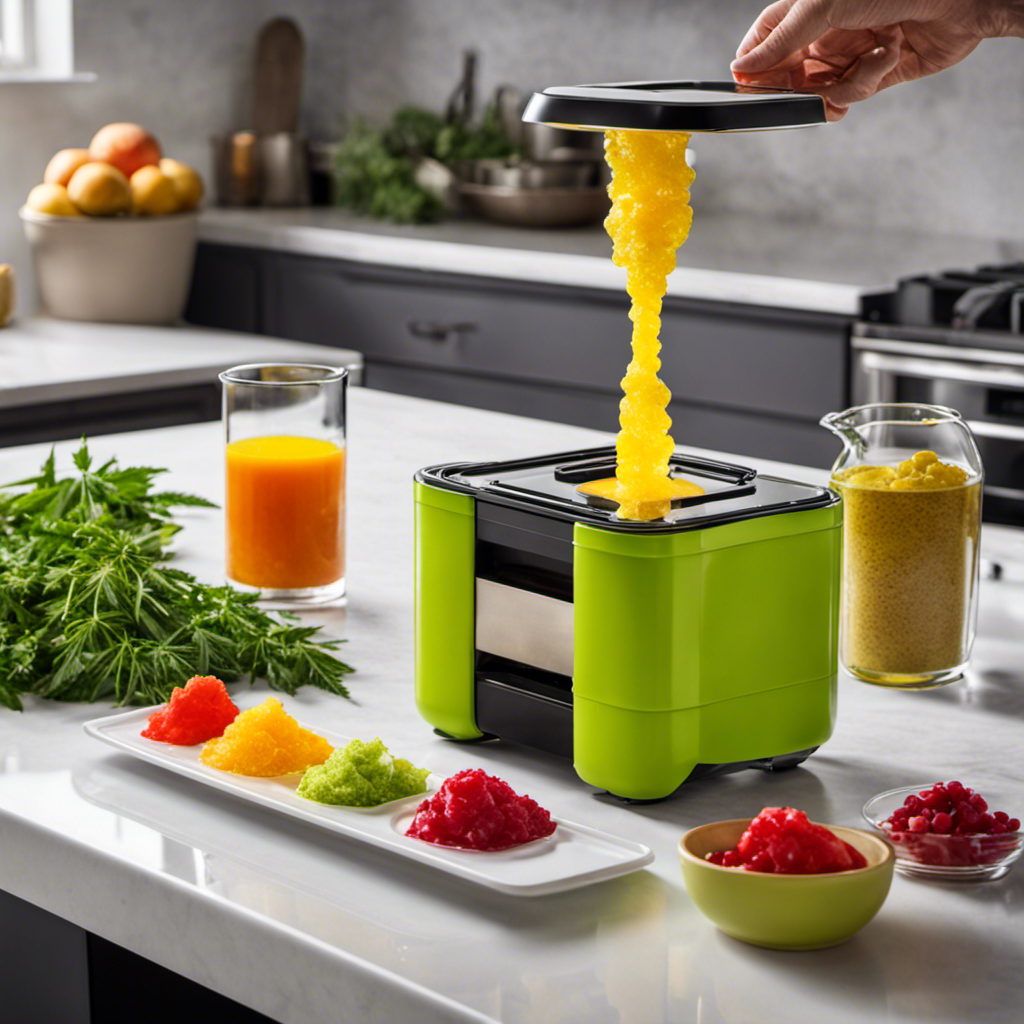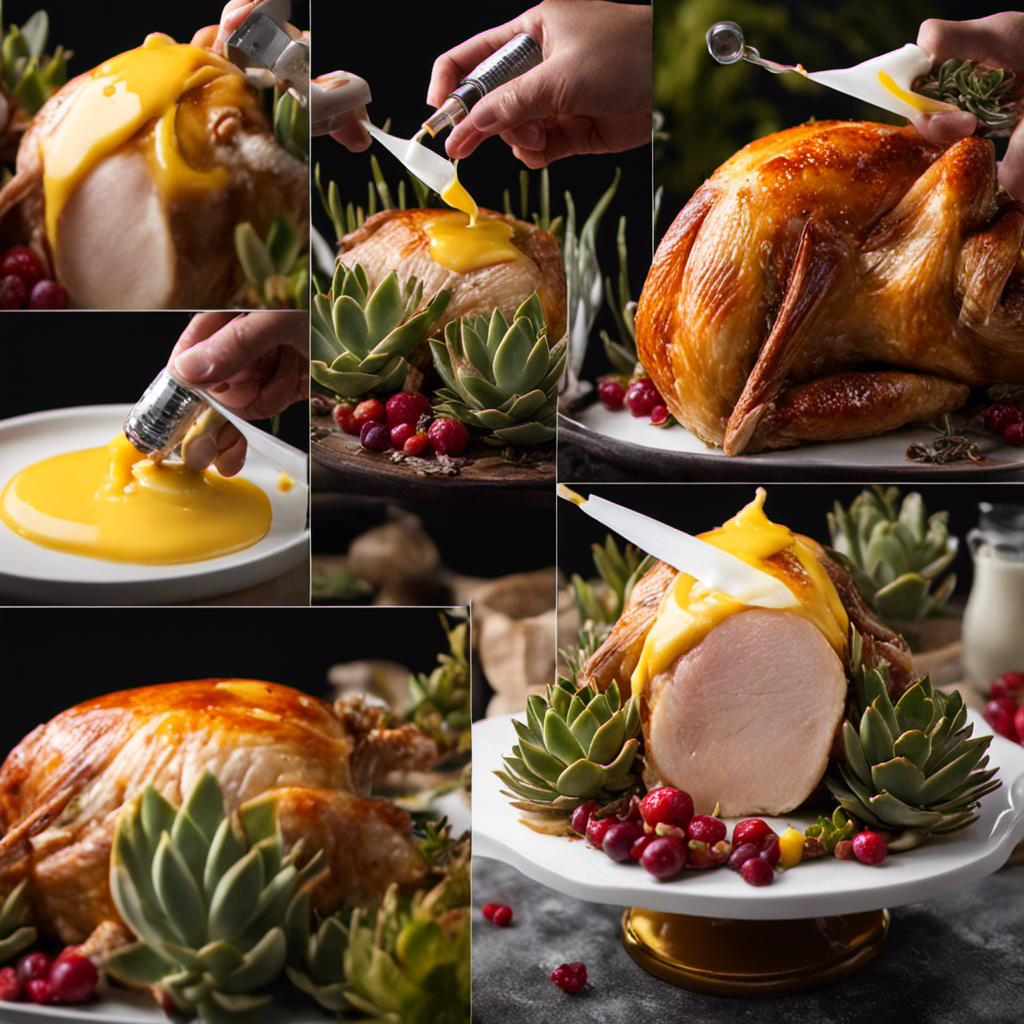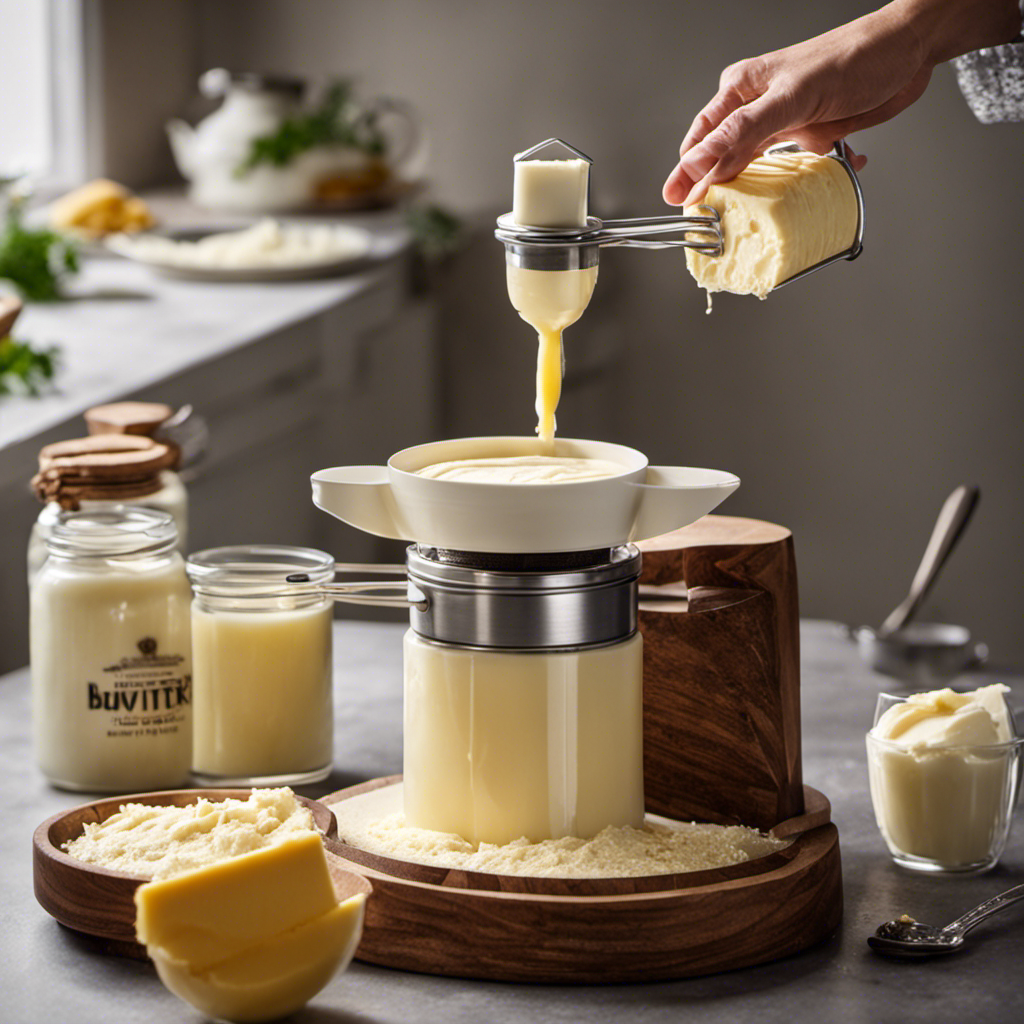Hello!
Ever wondered how to make delicious and potent weed gummies right at home? Look no further, because I’ve got you covered.
In this article, I’ll guide you through the step-by-step process of making mouthwatering weed gummies using the incredible Magical Butter Maker.
Get ready to embark on a journey where you’ll learn how to choose the perfect strain, activate the THC, infuse cannabis into butter, and create the perfect gummy mixture.
So, grab your apron and let’s dive into the world of homemade weed gummies!
Key Takeaways
- Choosing the right strain with a balanced ratio of THC and CBD is crucial for desired potency and effects in weed gummies.
- Decarboxylation, the process of heating cannabis at a specific temperature, is essential for making THC psychoactive in gummies.
- Infusing cannabis into unsalted butter using the Magical Butter Maker simplifies and enhances the infusion process.
- Precise measurements, accurate dosing, and proper mixing and heating are necessary for achieving the desired consistency and dosage of weed gummies.
Choosing the Right Strain for Weed Gummies
You’ll want to choose a strain of cannabis that has a balanced ratio of THC and CBD for your weed gummies. The strain selection is crucial as it determines the potency and effects of your gummies. When it comes to making weed gummies, it’s important to consider both the THC and CBD content to achieve a well-balanced experience.
THC (tetrahydrocannabinol) is the psychoactive compound in cannabis that provides the euphoric effects, while CBD (cannabidiol) is known for its relaxing and therapeutic properties. A balanced ratio of THC and CBD ensures that your gummies offer a pleasant and enjoyable experience without being overwhelming.
Furthermore, strain selection also plays a role in the flavor customization of your gummies. Different strains have distinct flavors and aromas, ranging from fruity and citrusy to earthy and herbal. By choosing a strain with a flavor profile that complements your desired taste, you can enhance the overall experience of your weed gummies.
Now that you understand the importance of strain selection and flavor customization, let’s move on to the next step: decarboxylation, which is crucial for activating the THC in your cannabis.
Decarboxylation: Activating the THC
Decarboxylation is a crucial step in the process of making weed gummies, as it activates the THC in the cannabis flower, making it psychoactive. This process involves heating the cannabis at a specific temperature to convert the non-psychoactive THCA into the psychoactive THC.
There are several methods to decarboxylate cannabis, including oven decarboxylation, sous vide decarboxylation, and using a decarboxylation device like the Nova Decarboxylator.
Importance of Decarboxylation
To maximize the potency of your weed gummies, it’s crucial to properly decarboxylate your cannabis before infusing it with the Magical Butter Maker. Decarboxylation is the process of activating the THC in your cannabis by applying heat.
Here are some key reasons why temperature control and debunking decarboxylation myths are important:
-
Importance of temperature control:
-
Consistent temperature ensures even decarboxylation throughout the cannabis.
-
High temperatures can degrade the cannabinoids and terpenes, reducing the overall potency and flavor.
-
Decarboxylation myths:
-
Myth 1: "Microwaving the cannabis will decarboxylate it quickly." In reality, microwaving can lead to uneven heating and inconsistent results.
-
Myth 2: "Decarboxylation can be skipped if using the Magical Butter Maker." This is false. Decarboxylation is necessary to activate the THC and maximize the potency of your gummies.
Decarboxylation Methods Explained
Understanding the different methods of decarboxylation can help you activate the THC in your cannabis effectively.
Decarboxylation is a process that converts the non-psychoactive THCA compound found in raw cannabis into the psychoactive THC compound.
There are various techniques you can use to achieve this.
One popular method is oven decarboxylation, which involves baking your cannabis at a specific temperature and time to activate the THC.
Another method is using a decarboxylation device, such as a decarboxylator, which precisely controls the temperature and time for optimal THC activation.
Each method has its own benefits, such as convenience, accuracy, and efficiency.
Gathering the Necessary Ingredients
First, you’ll want to make sure you have all the necessary ingredients for making weed gummies with the magical butter maker. Here’s a list of what you’ll need:
-
Cannabis strain: Choosing the right cannabis strain is crucial for achieving the desired effects in your gummies. Opt for a strain that is high in THC if you want a more potent experience, or choose a strain with higher levels of CBD for a more calming effect.
-
Butter: Infusing butter with cannabis is an essential step in making weed gummies. Use unsalted butter for better control over the flavor and consistency of your gummies.
-
Magical butter maker: This device will make the infusion process much easier and more efficient. It allows you to infuse butter with cannabis at the perfect temperature and time, ensuring maximum potency.
-
Gummy molds: To give your gummies their iconic shape, you’ll need silicone gummy molds. These are readily available online or at baking supply stores.
Once you have gathered all the necessary ingredients, you can move on to the next step of infusing cannabis into butter with the magical butter maker. This process will ensure that your gummies are infused with the cannabinoids and flavors of your chosen strain effectively.
Infusing Cannabis Into Butter With the Magical Butter Maker
When it comes to infusing cannabis into butter, the process can be time-consuming and tricky to get right. However, with the help of the Magical Butter Maker, the task becomes much more efficient and effective.
In this discussion, I will delve into the butter infusion process using the Magical Butter Maker and explore its effectiveness in producing high-quality cannabis-infused butter.
Butter Infusion Process
To start infusing the butter, you’ll need to decarboxylate the cannabis by baking it in the oven. This process activates the THC in the cannabis, making it more potent. Once decarboxylated, you can proceed with the butter infusion techniques using the Magical Butter Maker.
Here’s a step-by-step guide to achieve the perfect butter infusion for your gummies:
- Grind the decarboxylated cannabis into a fine powder.
- Place the cannabis and butter into the Magical Butter Maker, ensuring that the butter covers the cannabis completely.
- Set the temperature to 160 degrees Fahrenheit and the time to two hours.
- Stir the mixture occasionally to ensure even infusion.
- After the infusion is complete, strain the butter to remove any plant material.
- Let the butter cool and solidify before using it in your gummy recipe.
Following these butter infusion tips will help you achieve a smooth and potent cannabis-infused butter, resulting in gummies with the perfect consistency.
Magical Butter Maker Effectiveness
Now that we understand the butter infusion process, let’s explore the effectiveness of using a Magical Butter Maker for making weed gummies.
While the Magical Butter Maker is a popular choice for infusing butter with cannabis, there are alternatives available for those who don’t have access to this specific device. One alternative is to use a slow cooker or a double boiler to infuse the butter with cannabis. These methods require more hands-on attention, but they can still yield excellent results.
When using the Magical Butter Maker, it streamlines the process and ensures consistent and precise infusion. The machine’s temperature and time settings are specifically designed for creating potent cannabis-infused butter. Additionally, its built-in blending and straining capabilities make the process much easier and faster.
However, if you don’t have a Magical Butter Maker, don’t worry! There are still effective butter infusion techniques you can use.
With the butter infused, it’s time to move on to preparing the gummy mixture.
Preparing the Gummy Mixture
Mix all the ingredients together until well combined.
The gummy recipe variations are endless, and one way to switch things up is by using different sweeteners. Here are two options to consider:
-
Honey: Add a natural sweetness to your gummies by using honey as a sweetener. Not only does honey provide a delightful flavor, but it also offers some health benefits. It contains antioxidants and has antimicrobial properties, which can be beneficial for your immune system. Honey also adds a distinctive taste that pairs well with the cannabis-infused oil.
-
Agave syrup: For those looking for a vegan-friendly alternative, agave syrup is an excellent choice. It is derived from the agave plant and has a mild, sweet taste. Agave syrup is known for its low glycemic index, making it a suitable option for individuals with diabetes or those watching their sugar intake. It blends well with the other gummy ingredients and provides a pleasant sweetness to the final product.
Adding the Infused Butter to the Gummy Mixture
When it comes to making cannabis-infused gummies, there are a few key points to consider.
First, mastering the butter infusion technique is crucial for achieving the desired potency and flavor. I’ll share some tips and techniques on how to properly infuse butter with cannabis to ensure optimal results.
Additionally, achieving the perfect gummy consistency can be a bit tricky, so I’ll provide some helpful tips to ensure your gummies turn out just right.
Lastly, dosage considerations are essential to ensure a safe and enjoyable experience. I’ll discuss how to calculate the appropriate dosage for your gummies based on your desired strength and individual tolerance.
Butter Infusion Techniques
To achieve optimal butter infusion in your weed gummies, it’s important to follow the recommended techniques. Here are some tips for achieving consistent infusion:
- Choosing the right butter for infusion:
- Use unsalted butter for a cleaner taste in your gummies.
- Opt for high-quality butter with a higher fat content, as it will result in a more potent infusion.
Tips for achieving consistent infusion:
- Decarboxylate your weed before infusing it with butter. This process activates the THC, making it more potent.
- Use a Magical Butter Maker to ensure even distribution of the infused butter throughout your gummy mixture.
- Stir the melted butter and weed mixture frequently to prevent burning and ensure a consistent infusion.
- Strain the infused butter to remove any plant material, resulting in a smoother texture in your gummies.
Gummy Consistency Tips
When it comes to making weed gummies with the Magical Butter Maker, achieving the right gummy consistency is key. You want your gummies to have that perfect chewy texture that we all love.
To help you achieve this, I have some tips to share.
Firstly, make sure you follow the recipe instructions carefully. The Magical Butter Maker comes with a recipe book that provides precise measurements and steps to ensure the best results.
Secondly, consider using a gummy mold. This will give your gummies a professional look and help maintain their shape.
Lastly, don’t be afraid to experiment with flavor variations. You can add different extracts, juices, or even mix in some fruit puree to create unique and delicious gummy flavors.
Dosage Considerations for Gummies
Achieving the right dose of THC in your gummies is important for a consistent and enjoyable experience. To ensure accuracy when measuring the potency of your gummies, here are a few tips:
-
Use a reliable scale: Invest in a digital scale that measures in milligrams to accurately measure the amount of THC or CBD you’re adding to your gummy mixture.
-
Adjust potency: If your gummies are too strong or too weak, you can easily adjust the potency by adding more or less cannabis-infused oil or tincture.
-
For stronger gummies, increase the amount of infused oil or tincture.
-
For milder gummies, decrease the amount of infused oil or tincture.
By following these tips, you can ensure that each gummy contains the desired dosage of THC for a consistent and enjoyable experience.
Mixing and Heating the Gummy Mixture
After adding the cannabis-infused butter, proceed to mix and heat the gummy mixture until it becomes smooth and well combined. This step is crucial for achieving the perfect texture and flavor in your homemade weed gummies. Mixing and heating the gummy mixture properly ensures that the ingredients are evenly distributed and that the gummies set correctly.
To help you understand the process better, here’s a table outlining some gummy flavor variations and gummy texture adjustments you can make:
| Flavor Variation | Texture Adjustment |
|---|---|
| Lemon | Chewy |
| Strawberry | Soft and Gooey |
| Blueberry | Firm and Bouncy |
| Watermelon | Jelly-like |
Experimenting with different flavors and textures can add excitement to your gummy-making journey. Whether you prefer a tangy lemon flavor or a juicy strawberry taste, adjusting the texture can also enhance the overall experience. For a chewier gummy, you can reduce the heating time slightly, while a softer and gooier texture can be achieved by increasing the amount of gelatin.
Remember to mix the gummy mixture continuously while heating to prevent any lumps from forming. Heating the mixture over low heat ensures that the cannabis-infused butter is fully incorporated while maintaining the potency of the THC. Once the mixture is smooth and well combined, you can proceed to pour it into the gummy molds and allow it to set.
Pouring the Gummy Mixture Into Molds
When it comes to making gummies, there are a few key points to consider: molding techniques, proper filling of molds, and mold selection and preparation.
Molding techniques for gummies involve determining the shape and size you want for your gummies, as well as the type of mold you will be using.
Proper filling of molds is important to ensure consistent and evenly shaped gummies, which can be achieved by using a piping bag or a spoon to carefully fill each mold.
Lastly, mold selection and preparation involves choosing the right type of mold for your gummies, whether it’s silicone, plastic, or metal, and properly preparing the mold by greasing it or using a non-stick spray to prevent sticking.
Molding Techniques for Gummies
To get the perfect gummy shape, you’ll need to use the right molding techniques when making weed gummies with the magical butter maker. Here are some tips to enhance the texture and shape of your gummies:
-
Use silicone molds: Silicone molds are flexible and make it easy to remove the gummies without damaging their shape.
-
Chill the mixture: Before pouring the gummy mixture into the molds, make sure it is chilled. This helps the mixture to set quickly and maintain its shape.
-
Fill the molds evenly: To ensure consistent shapes, fill each mold cavity with an equal amount of the gummy mixture. This avoids any lopsided or uneven gummies.
-
Tap out air bubbles: After pouring the mixture into the molds, gently tap the molds on a flat surface to remove any air bubbles. This helps in achieving a smooth and uniform texture.
-
Refrigerate for optimal setting: Once the molds are filled, refrigerate the gummies for at least 2 hours or until firm. This allows the gummies to fully set and hold their shape.
Proper Filling of Molds
For even and consistent gummy shapes, remember to evenly fill each mold cavity with the chilled gummy mixture. When making gummies, it’s important to use the right mold to achieve the desired shape and size.
While traditional gummy molds are readily available, there are also alternative options you can explore. Silicone molds, for example, are a popular choice as they are flexible and easy to remove the gummies from.
When filling the molds, take care to distribute the gummy mixture evenly in each cavity. This can be done using a spoon or a pipette for more precise filling. Make sure not to overfill the molds, as this can result in misshapen gummies.
Once the molds are filled, allow the gummies to set completely before removing them.
Now that you know some filling technique tips, let’s move on to mold selection and preparation.
Mold Selection and Preparation
Silicone molds are a flexible and popular option for creating gummy shapes. When it comes to mold selection and preparation, there are a few important things to keep in mind. Here’s what you need to know:
-
Mold Cleaning:
Before using your silicone molds, it’s crucial to clean them thoroughly. This ensures that there are no contaminants or residue that could affect the quality of your gummies. To clean silicone molds, simply wash them with warm, soapy water and rinse them well. You can also use a soft brush or sponge to remove any stubborn residue. -
Gummy Texture:
Silicone molds are known for their ability to create smooth and detailed gummy shapes. The flexibility of the molds allows for easy removal of the gummies without affecting their texture. To achieve the desired gummy texture, make sure to follow the recipe instructions accurately. The right balance of ingredients and proper mixing will help you achieve the perfect consistency for your gummies.
Setting and Cooling the Gummies
Once the gummy mixture has been poured into the molds, I let them sit and cool for at least two hours. This step is crucial for achieving the perfect gummy texture. Allowing enough time for the gummies to set ensures that they firm up and hold their shape. It also gives the flavors time to meld together, resulting in a more delicious and enjoyable treat.
To further enhance the gummy texture, I have found a couple of tips that can make a difference. First, adding a small amount of citric acid to the mixture can help improve the chewiness. Citric acid acts as a natural flavor enhancer and can give the gummies a nice tangy kick. Second, using a silicone mold instead of a traditional plastic one can also contribute to a better texture. Silicone molds are more flexible, making it easier to remove the gummies without causing any damage or altering their shape.
When it comes to storing the gummies, it’s important to keep them in a cool and dry place. Heat and humidity can cause the gummies to become sticky or melt. I recommend storing them in an airtight container or a resealable bag to maintain their freshness and prevent any moisture from getting in.
Removing the Gummies From the Molds
To easily remove the gummies from the molds, simply press on the bottom of each mold cavity and gently pop them out. Here are some mold removal techniques and gummy demolding tips that can help you with this process:
-
Prepare the workspace: Before removing the gummies from the molds, make sure you have a clean and flat surface to work on. This will prevent any accidental damage to the gummies.
-
Apply gentle pressure: Place your fingers on the bottom of the mold cavity and apply gentle pressure. This will help loosen the gummy and make it easier to remove.
-
Use a silicone mold: Silicone molds are flexible and make it easier to remove the gummies without damaging their shape. The flexibility of the mold allows you to push on the bottom and pop the gummies out effortlessly.
-
Chill the molds: If you’re having trouble removing the gummies, you can try chilling the molds in the refrigerator for a few minutes. This can help solidify the gummies and make them easier to remove.
-
Be patient: Sometimes, gummies can be stubborn and may require a bit of patience. Take your time and gently work on removing each gummy from the mold.
Storing and Preserving Weed Gummies
If you want to store and preserve your weed gummies, you should keep them in an airtight container to maintain their freshness. Proper storage is essential to extend the shelf life of your gummies and ensure they stay potent and delicious. Here are some gummy storage tips to help you make the most of your cannabis-infused treats:
| Storage Tip | Description |
|---|---|
| Keep in a cool, dark place | Heat and light can degrade the potency of your gummies, so store them in a cool, dark area, such as a pantry or cupboard. |
| Avoid moisture | Moisture can cause your gummies to become sticky and lose their texture. Make sure the container is completely dry before storing your gummies. |
| Separate flavors | To prevent flavors from mixing, store different flavors of gummies in separate containers or use dividers within the container. |
| Label the container | Properly label the container with the date of preparation to keep track of the gummies’ freshness. |
| Don’t freeze | Freezing gummies can change their texture and make them less enjoyable to eat. It’s best to avoid freezing them. |
Calculating the THC Dosage in Weed Gummies
Now that we know how to store and preserve our delicious weed gummies, let’s dive into the world of calculating THC dosage. It’s important to know exactly how potent our gummies are, so we can consume them responsibly and enjoy the experience to the fullest.
Here’s how to calculate the potency and measure the dosage of your weed gummies:
-
Start by determining the total amount of THC in the cannabis you used to make the infused oil or butter. This information can usually be found on the packaging of the cannabis product.
-
Next, calculate the total amount of infused oil or butter you used in your gummy recipe.
-
Divide the total amount of THC by the total amount of infused oil or butter to find the concentration of THC per unit of oil or butter.
-
Now, determine the number of gummies you made and multiply it by the concentration of THC per unit of oil or butter. This will give you the total amount of THC in your batch of gummies.
-
Finally, divide the total amount of THC in your batch by the number of gummies to find the dosage of THC in each individual gummy.
Experimenting With Flavors and Additives
When experimenting with flavors and additives in your homemade edibles, remember to start with small amounts and gradually increase to find the perfect balance for your taste preferences.
There are countless flavor combinations and different types of additives you can try to enhance your edibles. Let me share some tips to help you navigate this exciting journey.
Firstly, when it comes to flavor combinations, the possibilities are endless. You can mix and match flavors to create unique and delicious treats. For example, you can try classic combinations like chocolate and mint, or get adventurous with tropical flavors like pineapple and coconut. Don’t be afraid to experiment and discover your own signature flavor combinations.
In addition to flavors, you can also experiment with different types of additives to enhance the texture and overall experience of your edibles. Additives like lecithin can improve the absorption of cannabinoids, while coconut oil can add a smooth and creamy texture. Other popular additives include fruit juices, essential oils, and even spices like cinnamon or ginger.
Remember, when adding flavors and additives, start with small amounts and gradually increase to avoid overpowering the taste or texture of your edibles. Keep a record of the combinations and amounts used, so you can replicate your favorite recipes in the future.
Have fun exploring the wonderful world of flavors and additives, and enjoy the delicious journey of creating your own unique homemade edibles.
Troubleshooting Common Issues With Weed Gummies
One common issue with homemade edibles is that the gummies may turn out too sticky or gooey, which can be solved by adjusting the amount of gelatin used in the recipe. Troubleshooting gummy consistency is key to ensure that your homemade edibles turn out just right.
Here are a few tips to help you troubleshoot and achieve the perfect gummy texture:
-
Adjusting the amount of gelatin:
If your gummies are too sticky or gooey, try reducing the amount of gelatin in the recipe. This will result in a firmer texture.
On the other hand, if your gummies are too firm or hard, you can increase the amount of gelatin to achieve a softer consistency. -
Adjusting the dosage for desired effects:
If you find that your gummies are not potent enough, you can increase the amount of cannabis-infused oil or tincture in the recipe.
Conversely, if your gummies are too strong, you can decrease the amount of cannabis-infused oil or tincture.
Exploring Alternative Methods for Making Weed Gummies
If you’re looking for different ways to create cannabis-infused gummies, you can try using a tincture or cannabis oil as an alternative method. Making weed gummies is a fun and tasty way to enjoy the benefits of cannabis.
One popular method for making these delicious treats is by using a magical butter maker. This handy device can simplify the process and provide consistent results.
The magical butter maker is a versatile kitchen appliance that can be used to infuse cannabis into various recipes, including gummies. It allows you to extract the cannabinoids from the plant material and incorporate them into your gummy mixture. This ensures that each gummy contains a consistent dosage of THC or CBD, depending on your desired effects.
Using the magical butter maker for your weed gummy recipes has several benefits. First, it saves time and effort by automating the process of infusing cannabis into your gummy mixture. The machine does all the work for you, ensuring that the cannabinoids are evenly distributed throughout the gummies.
Additionally, the magical butter maker allows for precise control over dosage. You can easily adjust the strength of your gummies by adding more or less cannabis to the machine. This ensures that you can customize your gummies to suit your preferences and desired effects.
Frequently Asked Questions
Can I Use a Different Type of Butter Instead of Infusing Cannabis Into Butter With the Magical Butter Maker?
Yes, you can use different types of oils for infusing cannabis instead of butter with the Magical Butter Maker. However, using butter has its benefits, like its ability to bind to THC and enhance the effects of cannabis in gummies.
What Are Some Common Additives That Can Be Used to Enhance the Flavors of Weed Gummies?
There are many flavoring options and recipe variations that can enhance the flavors of weed gummies. Some common additives include fruit extracts, essential oils, and flavored gelatin. These can add depth and variety to your homemade gummies.
How Can I Troubleshoot Issues With Gummies Not Setting Properly?
When making weed gummies, troubleshooting the consistency is key. To prevent them from melting, ensure proper temperature control and use the right amount of gelatin. Experimentation and patience are crucial for perfecting the process.
Are There Any Alternative Methods for Making Weed Gummies Without Using the Magical Butter Maker?
There are alternative methods to make weed gummies without the Magical Butter Maker. You can use other butter or oil infusions and follow a similar recipe. The type of butter used can affect the texture of the gummies.
How Can I Calculate the THC Dosage in Weed Gummies for Accurate Dosing?
To calculate the THC dosage in weed gummies accurately, start by measuring the potency of your cannabis. Use a formula to determine the amount of THC per serving, ensuring precise dosing for a consistent experience.
Conclusion
In conclusion, making weed gummies with the Magical Butter Maker has been an incredible journey. From choosing the perfect strain to infusing cannabis into butter, each step has been crucial in creating the ultimate edible experience.
By experimenting with flavors and additives, the possibilities are endless. However, it’s important to troubleshoot any common issues that may arise. And for those who prefer alternative methods, there are plenty of options to explore.
So grab your Magical Butter Maker and get ready to indulge in some delicious, mind-altering treats. You won’t be disappointed!









